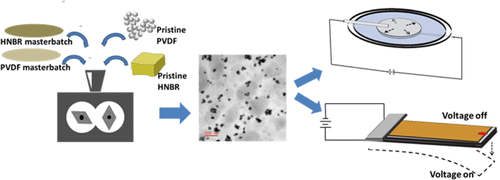当前位置:
X-MOL 学术
›
Ind. Eng. Chem. Res.
›
论文详情
Our official English website, www.x-mol.net, welcomes your
feedback! (Note: you will need to create a separate account there.)
Polyvinylidene Fluoride/Hydrogenated Nitrile Rubber-Based Flexible Electroactive Polymer Blend and Its Nanocomposites with Improved Actuated Strain: Characterization and Analysis of Electrostrictive Behavior
Industrial & Engineering Chemistry Research ( IF 3.8 ) Pub Date : 2020-02-14 , DOI: 10.1021/acs.iecr.9b05526 Subhabrata Saha 1 , Anil K. Bhowmick 1 , Ajeet Kumar 2 , Karali Patra 2 , Pierre-Jean Cottinet 3 , Kritsadi Thetpraphi 3
Industrial & Engineering Chemistry Research ( IF 3.8 ) Pub Date : 2020-02-14 , DOI: 10.1021/acs.iecr.9b05526 Subhabrata Saha 1 , Anil K. Bhowmick 1 , Ajeet Kumar 2 , Karali Patra 2 , Pierre-Jean Cottinet 3 , Kritsadi Thetpraphi 3
Affiliation

|
A polyvinylidene fluoride (PVDF)/hydrogenated nitrile rubber (HNBR)-based flexible electroactive polymer blend was developed by generating a suitable morphology that showed a judicious combination of strength and flexibility. The blend, containing 30:70 wt/wt ratio of PVDF/HNBR, was thermoplastic elastomeric in nature and exhibited visible planar actuation in the presence of an electric field. To the best of our knowledge, the electromechanical actuation of the thermoplastic elastomeric blend has been reported for the first time. The maximum planar strain was 5%, and the actuation was triggered by the strong induced polarization in both PVDF and HNBR phases that gave rise to a high dielectric constant and low dielectric losses. The interphase between PVDF and HNBR was also very strong, which made the thermoplastic elastomer (TPE) susceptible to withstand high electric field. The TPE also exhibited a bending actuation of 0.6 mm at a low electric field of 20 kV/mm, promising enough to be used in microdevices. Addition of barium titanate (BT) nanoparticles increased the dielectric constant as they were homogeneously distributed in both the phases. The maximum planar actuation (∼10%) was observed at 10 wt % BT loading, whereas 5 wt % loading exhibited the maximum dielectric strength (∼120 kV/mm). At 5 wt % loading, the bending actuation was 0.9 mm at 20 kV/mm, which was 50% higher than that of unfilled TPE. Both the TPE and its nanocomposite also showed good history dependency in a cyclic electric field. In summary, the study provides an attractive and unexplored alternative of developing electromechanically active TPEs and their nanocomposites.
中文翻译:

聚偏氟乙烯/氢化丁腈橡胶基柔性电活性聚合物共混物及其具有改进的驱动应变的纳米复合材料:电致伸缩行为的表征和分析
聚偏二氟乙烯(PVDF)/氢化丁腈橡胶(HNBR)基的柔性电活性聚合物共混物通过产生合适的形态来开发,该形态显示出强度和柔性的明智结合。包含30:70 wt / wt比例的PVDF / HNBR的共混物本质上是热塑性弹性体,在电场存在下表现出可见的平面驱动作用。据我们所知,首次报道了热塑性弹性体混合物的机电致动。最大平面应变为5%,驱动是由PVDF和HNBR相中的强感应极化触发的,从而导致高介电常数和低介电损耗。PVDF和HNBR之间的界面也非常牢固,这使得热塑性弹性体(TPE)易于承受高电场。TPE在20 kV / mm的低电场下也表现出0.6 mm的弯曲驱动力,有望在微器件中使用。钛酸钡(BT)纳米粒子的添加增加了介电常数,因为它们均匀地分布在两个相中。在10 wt%的BT负载下观察到最大平面激励(〜10%),而5 wt%的负载显示出最大的介电强度(〜120 kV / mm)。在5 wt%的载荷下,弯曲致动在20 kV / mm时为0.9 mm,比未填充的TPE高50%。TPE及其纳米复合材料在循环电场中也显示出良好的历史依赖性。综上所述,
更新日期:2020-02-17
中文翻译:

聚偏氟乙烯/氢化丁腈橡胶基柔性电活性聚合物共混物及其具有改进的驱动应变的纳米复合材料:电致伸缩行为的表征和分析
聚偏二氟乙烯(PVDF)/氢化丁腈橡胶(HNBR)基的柔性电活性聚合物共混物通过产生合适的形态来开发,该形态显示出强度和柔性的明智结合。包含30:70 wt / wt比例的PVDF / HNBR的共混物本质上是热塑性弹性体,在电场存在下表现出可见的平面驱动作用。据我们所知,首次报道了热塑性弹性体混合物的机电致动。最大平面应变为5%,驱动是由PVDF和HNBR相中的强感应极化触发的,从而导致高介电常数和低介电损耗。PVDF和HNBR之间的界面也非常牢固,这使得热塑性弹性体(TPE)易于承受高电场。TPE在20 kV / mm的低电场下也表现出0.6 mm的弯曲驱动力,有望在微器件中使用。钛酸钡(BT)纳米粒子的添加增加了介电常数,因为它们均匀地分布在两个相中。在10 wt%的BT负载下观察到最大平面激励(〜10%),而5 wt%的负载显示出最大的介电强度(〜120 kV / mm)。在5 wt%的载荷下,弯曲致动在20 kV / mm时为0.9 mm,比未填充的TPE高50%。TPE及其纳米复合材料在循环电场中也显示出良好的历史依赖性。综上所述,











































 京公网安备 11010802027423号
京公网安备 11010802027423号